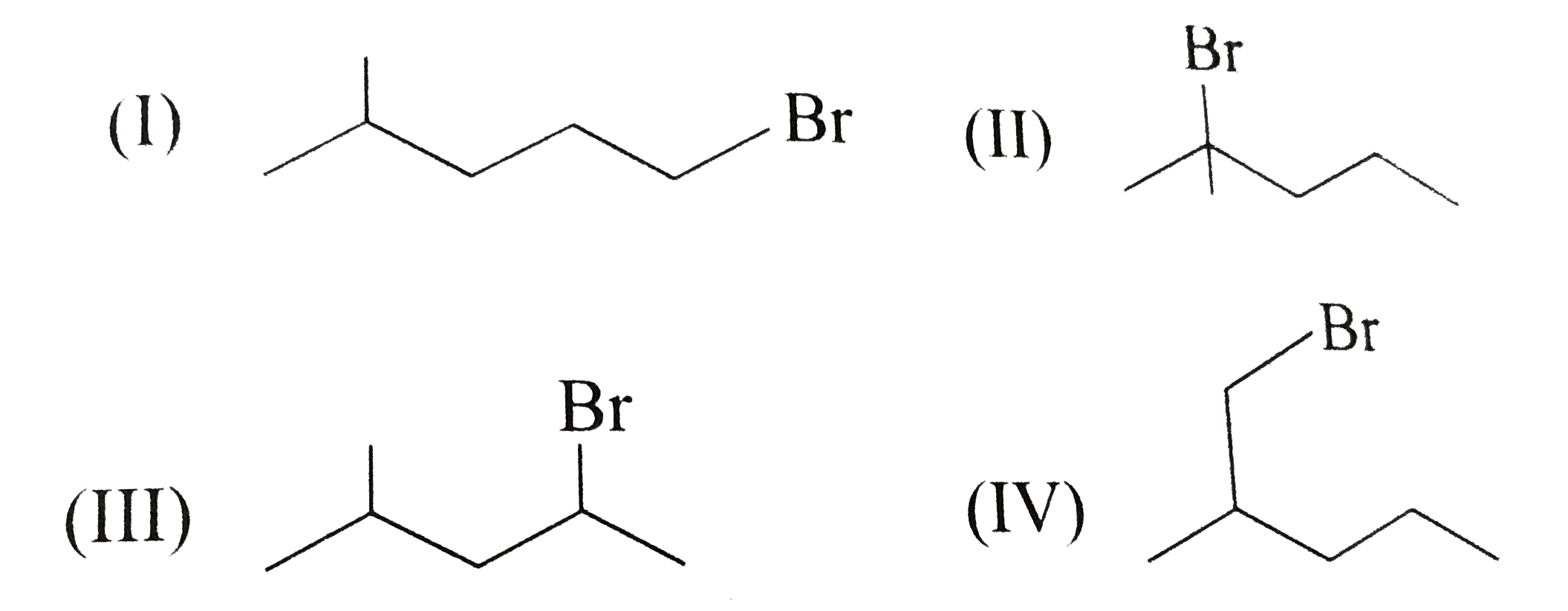In Chlorobenzene(I),2,4-dinitrochlorobenzene(II),p- nitrochlorobenzene(III)
The decreasing order of reactivity towards electrophliic substitution reaction is
(I) gt (II) gt (III)
(I) gt (III) gt (II)
(II) gt (I) gt (III)
(III) gt (I) gt (II)
The correct Answer is:2
To determine the decreasing order of reactivity towards electrophilic substitution reactions for the compounds chlorobenzene, 2,4-dinitrochlorobenzene, and p-nitrochlorobenzene, we need to analyze the effects of the substituents (chlorine and nitro groups) on the electron density of the benzene ring.
1. Identify the Compounds:
- (I) Chlorobenzene
- (II) 2,4-Dinitrochlorobenzene
- (III) p-Nitrochlorobenzene
2. Understand the Effects of Substituents:
- The chlorine atom (Cl) is an electron-donating group through resonance, which increases the electron density of the benzene ring.
- The nitro group (NO2) is an electron-withdrawing group through resonance and inductive effects, which decreases the electron density of the benzene ring.
3. Analyze Each Compound:
- Chlorobenzene (I): Contains only the chlorine substituent, which donates electron density to the ring, making it more reactive towards electrophilic substitution.
- 2,4-Dinitrochlorobenzene (II): Contains two nitro groups at the 2 and 4 positions, which significantly withdraw electron density from the ring. Although it also has a chlorine atom, the effect of the two nitro groups will dominate, leading to a lower electron density compared to chlorobenzene.
- p-Nitrochlorobenzene (III): Contains one nitro group and one chlorine atom. The nitro group will withdraw some electron density, but not as much as in the case of 2,4-dinitrochlorobenzene. Thus, it has a higher electron density than 2,4-dinitrochlorobenzene but lower than chlorobenzene.
4. Rank the Reactivity:
- The compound with the highest electron density will be the most reactive towards electrophilic substitution.
- Therefore, the order of reactivity from highest to lowest is:
- (I) Chlorobenzene > (III) p-Nitrochlorobenzene > (II) 2,4-Dinitrochlorobenzene
Final Answer:
The decreasing order of reactivity towards electrophilic substitution reaction is:
Chlorobenzene > p-Nitrochlorobenzene > 2,4-Dinitrochlorobenzene
---
- (I) Chlorobenzene
- (II) 2,4-Dinitrochlorobenzene
- (III) p-Nitrochlorobenzene
- The chlorine atom (Cl) is an electron-donating group through resonance, which increases the electron density of the benzene ring.
- The nitro group (NO2) is an electron-withdrawing group through resonance and inductive effects, which decreases the electron density of the benzene ring.
- Chlorobenzene (I): Contains only the chlorine substituent, which donates electron density to the ring, making it more reactive towards electrophilic substitution.
- 2,4-Dinitrochlorobenzene (II): Contains two nitro groups at the 2 and 4 positions, which significantly withdraw electron density from the ring. Although it also has a chlorine atom, the effect of the two nitro groups will dominate, leading to a lower electron density compared to chlorobenzene.
- p-Nitrochlorobenzene (III): Contains one nitro group and one chlorine atom. The nitro group will withdraw some electron density, but not as much as in the case of 2,4-dinitrochlorobenzene. Thus, it has a higher electron density than 2,4-dinitrochlorobenzene but lower than chlorobenzene.
- The compound with the highest electron density will be the most reactive towards electrophilic substitution.
- Therefore, the order of reactivity from highest to lowest is:
- (I) Chlorobenzene > (III) p-Nitrochlorobenzene > (II) 2,4-Dinitrochlorobenzene
The decreasing order of reactivity towards electrophilic substitution reaction is:
Chlorobenzene > p-Nitrochlorobenzene > 2,4-Dinitrochlorobenzene
Topper's Solved these Questions
- HYDROCARBONSBOOK - AAKASH INSTITUTECHAPTER - HYDROCARBONSEXERCISE - Assignment(Section - B) (Obejctive type question)
13 Videos
- HYDROCARBONSBOOK - AAKASH INSTITUTECHAPTER - HYDROCARBONSEXERCISE - Assignment(Section - C) (Previous Years Questions)
69 Videos
- HYDROCARBONSBOOK - AAKASH INSTITUTECHAPTER - HYDROCARBONSEXERCISE - Exercise
50 Videos
- HALOALKANES AND HALOARENES BOOK - AAKASH INSTITUTECHAPTER - HALOALKANES AND HALOARENES EXERCISE - ASSIGNMENT SECTION -D
15 Videos
- HYDROGENBOOK - AAKASH INSTITUTECHAPTER - HYDROGENEXERCISE - ASSIGNMENT (SECTION - D) (Assertion-Reason Type question)
15 Videos
Similar Questions
Knowledge Check

The correct order of reactivity of I, II & III towards addition reactions is:AI gt III gt IIBI gt II gt IIICIII gt II gt IDIII gt I gt IICH3a−CH2b−CH2c−CH2d−F
Arrange the hydrogens a, b, c, d, in decreasing order of their reactivities towards chlorination:Aa>b>c>dBb>c>d>aCb>c>a>dDc>b>a>dArrange the following in decreasing order of reactivity towards electrophilic substitution reaction
Aniline (I) , Acetanilide (II)
phenol (III) , Anilinium chloride (IV)AII>I>III>IVBI>III>II>IVCIII>II>IV>IDIV>II>I>III
In
−NO2(i),−NH2(ii),−SO3H(iii) ,
The decreasing order of -I effect is
View Solution(a) Arrange alkyl halides water and alkane in order of decreasing density .
(b) Arrange chloromethanes and water in order of decreasing density.
(c) Arrange MeX in order of decreasing bond length.
(d) Arrange MeX in order of decreasing bond strength.
(e) Arrange MeX in order of activity.
(f) Arrange alkyl halides (1∘,2∘,3∘) in order of decreasing SN2 reactivity.
(g) Arrange the order of reactivity of alcohols towards HX.
(h) Arrange the decreasing order of reactivity in haloforms.
(i) Arrange the following isomeric bromides in order of decreasing reactivity in SN2 displacement:

(b) 2-Bromo-2- methylbutane(I),1−Bromopentane(II),
2−Bromopentane(III)
(C)1−Bromo-3-methylbutane(I),2−Bromo-2-methylbutane(II)
2−Bromo-3-methylbutane(III)
(d)1−Bromobutane(I),1−Bromo-2- methylbutane(II)
1−Bromo -3- methylbutaneIII
1−Bromo-2,2-dimethylpropane(IV)
View SolutionIt is easy to substitute −Cl in 2,4-dinitrochlorobenzene than in chlorobenzene because _________.
View SolutionIn the compound,
CH2(I)=CH(II)=C=−CH(III)
The most acidic hydrogen atom is
View SolutionThe order of leaving group ability is
.−OAc(I).−OMe(II).−SO3Me(III).−SO3CF3(IV) The order of leaving group ability is
View Solution

